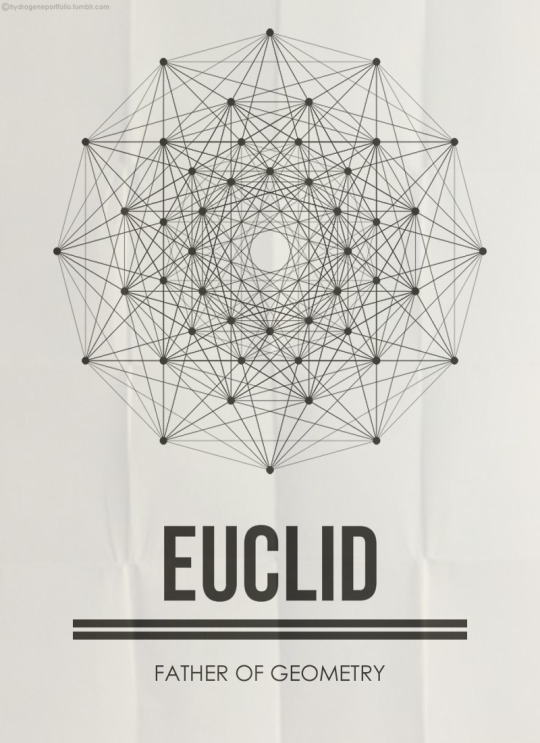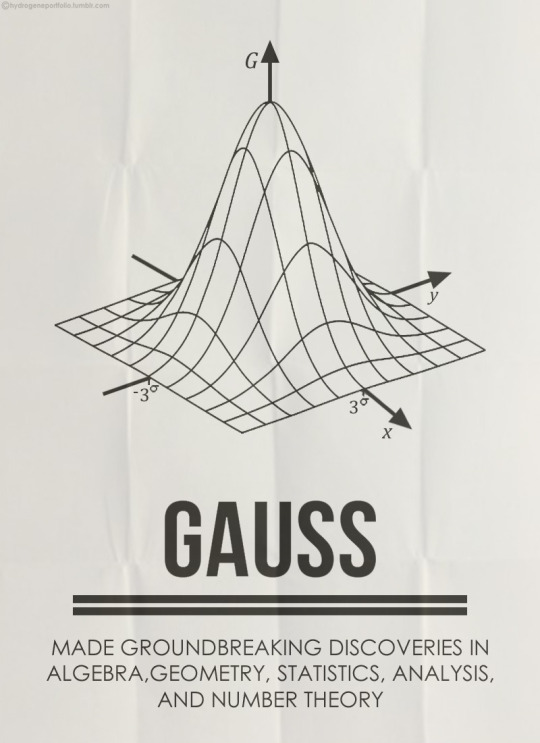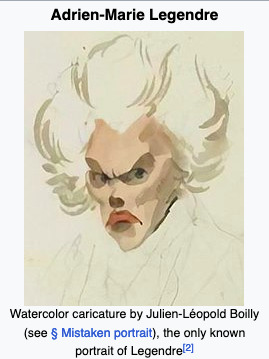#mathematicians
Text

Mathematician, physician and philosopher (1776-1831), Sophie Germain was a genius who fought hard to be heard a recognized.
A self-taught prodigy
The daughter of a silk merchant, Sophie was born in Paris to a relatively wealthy family. When the French Revolution broke out in 1789, her father became a member of the Constituent Assembly. Amidst the chaos, Sophie found solace in her father's library and discovered mathematics.
Fascinated by the subject, she learned everything she could, studying at night. Her parents disapproved. Mathematics was thought to be too complex for women who had to focus first and foremost on their home.
Sophie's parents tried to stop her by putting out the fire in her room at night and confiscating her clothes and candles after nightfall. Sophie's thirst for knowledge was stronger. According to her obituary, she studied “at night in a room so cold that the ink often froze in its well, working enveloped with covers by the light of a lamp”. She even taught herself Latin to read the essential works.
Sophie impresses
The École Polytechnique was founded in 1974 with to train a new elite of engineers, mathematicians and scientists. Being a woman, Sophie couldn’t attend. She learned that a student named Leblanc wasn’t able to go to class. She wrote to the school, pretending to be him, and managed to obtain lecture notes. She was also able to complete and submit assignments.
This promising student impressed mathematician Joseph-Louis Lagrange who found her answers brilliant. The self-taught Sophie had gained the admiration of one of the most renowned mathematicians of her time.
Lagrange's desire to meet her forced Sophie to reveal her real identity. Lagrange was at first surprised to learn that his correspondent was a woman. He nonetheless became Sophie’s mentor, introducing her to a new world and opportunities.
Sophie made major contributions to number theory. She worked on Fermat's last theorem, making major observations and creating her own theorem. This would be one of her major contributions to mathematics.
In 1804, she began a correspondence with another mathematician, Carl Friedrich Gauss, whose work she admired. He was similarly impressed by her intelligence:
“But how to describe to you my admiration and astonishment at seeing my esteemed correspondent Monsieur Leblanc metamorphose himself into this illustrious personage who gives such a brilliant example of what I would find it difficult to believe. A taste for the abstract sciences in general and above all the mysteries of numbers is excessively rare: one is not astonished at it: the enchanting charms of this sublime science reveal only to those who have the courage to go deeply into it. But when a person of the sex which, according to our customs and prejudices, must encounter infinitely more difficulties than men to familiarize herself with these thorny researches, succeeds nevertheless in surmounting these obstacles and penetrating the most obscure parts of them, then without doubt she must have the noblest courage, quite extraordinary talents and superior genius.”
An incomplete recognition
Sophie was also interested in physics. In 1811, she entered a contest held by the French Academy of Sciences, but her lack of formal education turned against her. She didn't give up and won the contest in 1816 with her Memoir on the vibrations of Elastic Plates. She kept working on the theory of elasticity and published several more memoirs. Her work would prove pivotal in the field.
This prize also meant official recognition for Sophie. In 1823, she became the first woman to be allowed at the Academy of Sciences' sessions. Though respected as an equal collaborator by some, she still felt like a “foreigner” in the scientific community.
Sophie Germain died at the age of 55, on June 27, 1831, after a battle with breast cancer. Carl Friedrich Gauss had convinced the university of the University of Gottingen to give her an honorary degree but Sophie was dead before she could receive it.
Her death certificate designated her as a "rentière-annuitant" (a single woman with no profession) instead of a mathematician.
Today, a street in Paris, schools in France and a crater on Venus are named in her honor. She appeared on a French postal stamp released in 2016.
Feel free to check out my Ko-Fi if you like what I do! Your support would be greatly appreciated.

Further reading
Alkalay-Houlihan Coleen, “Sophie Germain and special cases of Fermat’s last theorem”
Boyé Anne,, “Sophie Germain, une mathématicienne face aux préjugés de son temps”
“Biographies of women mathematicians : Sophie Germain”
Lamboley Gilbert, “Math’s hidden woman”
Koppe Martin, “Sophie Germain, une pionnière enfin reconnue”
#sophie germain#history#historyedit#women in history#19th century#france#french history#upthebaguette#herstory#mathematics#mathematicians#historical#historical figures#women in stem#european history#historyblr
49 notes
·
View notes
Text





Mathematicians Collection' by Hydrogene
93 notes
·
View notes
Text
Merry christmas to all who celebrate!
Among the people celebrating christmas some 400 years ago was Pierre de Fermat, who proved his *christmas theorem* this day!
Fermat's christmas theorem, better known as the two squares theorem, says that a prime number p can be expressed as a sum of two squares, i.e. p = a² + b², if and only if p is 1 mod 4.

Look at this jolly fellow
87 notes
·
View notes
Text
Yo math people, what was your first proof?
139 notes
·
View notes
Text

Can we talk about this portrait of Mathematician Adrien-Marie Legendre?
Why is nobody talking about this portrait of Adrien-Marie Legendre???
Like the fact that somebody thought a portrait of a different Legendre was him but actually it wasn't.
This random ass doodle is the only existing portrait of him omg.
#shitpost#wikipedia#math#mathematics#mathematicians#idk lol im bored#i know there's a tweet and a reddit post ok#but they are five years old#lets talk about it again#this will never catch on#im just bored ok#portrait#silly portraits#random bullshit#french people
57 notes
·
View notes
Text
Tumblr, specifically math Tumblr, meet Lemma the cat:




Her owners are two of my math professors, who are married to each other and live in a cottage called “pebble house” in the woods on the edge of campus.
She is my spirit animal.
🐈⬛🏡 🧮🏳️🌈
292 notes
·
View notes
Text
mathematician and philosopher frank ramsey is my fancast for henry winter

#ramsey#mathematicians#henry winter#the secret history#tsh#donna tartt#richard papen#philosophy#dark academia
42 notes
·
View notes
Text
Successfully trying out a few new coding techniques seemed like a fitting way to celebrate Alan Turing's birthday.
I successfully automated 9 additional processes today with fewer than 25 lines of code.
#computer programming#software engineering#software development#mathematicians#computer scientists#alan turing
43 notes
·
View notes
Text
Happy Birthday to my lover, Sir Isaac Newton

#isaac newton#science history#physics#on this day#newton#philosopher#philosophy#mathematicians#mathmatics#birthday
13 notes
·
View notes
Text

things heating up in the math fandom rn
227 notes
·
View notes
Text

The first recorded use of π as a mathematical symbol comes from the Welsh mathematician William Jones in a 1706 work called Synopsis Palmariorum Matheseos in which he abbreviated the Greek περιφέρεια to its first letter: π.
He wrote: “3.14159 andc. = π”
He explained that he chose this symbol because it was the initial letter of the word ‘Periphery’ or ‘Circumference.'
However, the use of π as a standard notation for Pi was popularized by another mathematician, Leonhard Euler, who adopted it in 1737.
Euler was one of the most influential and prolific mathematicians of all time.
He used π extensively in his work on calculus, number theory, geometry, and physics.
He wrote:
“Let π denote the ratio of the diameter of a circle to its circumference."
Since then, π has become a universal symbol for pi and one of the most recognizable and celebrated mathematical constants in the world.
—
William Jones, FRS (1675 – 1 July 1749) was a Welsh mathematician, most noted for his use of the symbol π (the Greek letter Pi) to represent the ratio of the circumference of a circle to its diameter.
He was a close friend of Sir Isaac Newton and Sir Edmund Halley.
In November 1711, he became a Fellow of the Royal Society and later its vice-president.
—
Leonhard Euler (15 April 1707 – 18 September 1783) was a Swiss mathematician, physicist, astronomer, geographer, logician, and engineer who founded the studies of graph theory and topology.
He made pioneering and influential discoveries in many other branches of mathematics, such as analytic number theory, complex analysis, and infinitesimal calculus.
He introduced much of modern mathematical terminology and notation, including the notion of a mathematical function.
He is also known for his work in mechanics, fluid dynamics, optics, astronomy, and music theory.
#π#pi#mathematical symbol#William Jones#Leonhard Euler#Synopsis Palmariorum Matheseos#mathematicians#mathematics#mathematical constants
20 notes
·
View notes
Text
looking up quotes from mathematicians and I don't think any of them will beat when the University of Göttingen was debating whether to make Emmy Noether a professor and David Hilbert said "Gentlemen, the faculty is not a pool changing room"
8 notes
·
View notes
Text
Sometimes you have to approach a math problem like the old Greeks did, from a new perspective and with a glass of wine in hand.
#math#mathematics#old greece#ancient greece#greece#greek#greeks#wine#greek mathematics#greek mathematicians#mathematicians#notsofriendlyfriendlyreminder
9 notes
·
View notes
Text
"The difference between the poet and the mathematician is that the poet tries to get his head into the heavens while the mathematician tries to get the heavens into his head."
G.K. Chesterton
#math quote#mathematics#mathematician#math#mathematicians#analogies#analogy#quote#having both a mathematical as well as poetic and artistic mindset I can fully agree on both sides depicted in that quote#poet#poetry and math#math and literature#lit#math and lit#philosophy#philo brabble#math appreciation#math is art#math is love#math passion#passion
132 notes
·
View notes
Text

Roger Penrose was born on August 8, 1931. A British mathematician, mathematical physicist, philosopher of science and Nobel Laureate in Physics. Penrose has contributed to the mathematical physics of general relativity and cosmology. He has received several prizes and awards, including the 1988 Wolf Prize in Physics, which he shared with Stephen Hawking for the Penrose–Hawking singularity theorems, and one half of the 2020 Nobel Prize in Physics "for the discovery that black hole formation is a robust prediction of the general theory of relativity". He is regarded as one of the greatest living physicists, mathematicians, and scientists, and is particularly noted for the breadth and depth of his work in both natural and formal sciences.
#roger penrose#mathematicians#mathematics#general relativity#cosmology#singularity#nobel prize#nobel prize winners#science#science history#science birthdays#on this day#on this day in science history
18 notes
·
View notes
Text
I've been pondering something and I need a mathematician to tell me if this is correct:
infinity multiplied by 1 is simultaneously equal to and less that infinity multiplied by 2.
it's less because 1 is less than 2 but they are also equal because both are infinite.
is this correct? or am I haunted by visions of a universe I don't understand?
#mathematics#science side of tumblr#science side help me#shrodinger speaks#science side of the internet#mathematicians#please help#ask tumblr
22 notes
·
View notes